Feeding horses high-quality hay not only maintains their health but ultimately saves owners money. Follow these best nutrition practices to ensure that your valued investment thrives.
Difficult financial times combined with drought may tempt many Alabama horse owners to try to save money by skimping on both the amount and quality of hay they feed their horses. Feeding horses less or poorer-quality hay, however, is not always the most economical solution and actually may be detrimental to a horse’s welfare.
Make Hay the Foundation of the Diet
Hay and other long-fiber forages, such as grass and sugar beet pulp, provide fill in the intestines (especially the cecum and colon, known collectively as the hindgut). This fill keeps food moving through the digestive tract, maintains a constant source of nutrients for the beneficial bacteria in the hindgut, and reduces intestinal twisting. Hay or other long-fiber forages should therefore be the foundation of the horse’s diet, with concentrate feeds (grains and pellets) added only when essential nutrients are not supplied in the forage.
The average pleasure horse usually can get all the nutrients it needs from good-quality forage along with water and minerals. Broodmares in late pregnancy or during lactation, growing horses, and hard-working horses have higher nutrient requirements and often need additional nutrients that are typically supplied by concentrate feeds.
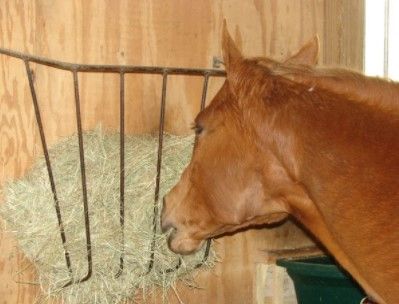
Forage should be the foundation of the horse’s diet.
All horses should receive a minimum of 1 percent of their body weight each day in long-fiber forage dry matter (DM) to prevent digestive problems. When allowed free-choice consumption of pasture or hay, horses often eat up to 2.5 percent of their body weight in dry matter daily. For example, an 1,100-pound horse needs a minimum of 11 pounds of long-fiber forage dry matter daily. When eating free-choice hay or pasture, this horse may voluntarily consume up to 27.5 pounds of dry matter each day. This amount represents pounds of actual dry matter consumed, and grass hays typically contain 84 to 87 percent dry matter. A horse consuming 27.5 pounds of dry matter actually will be eating 31 to 32 pounds of hay. In contrast, a lush spring grass may be only 20 percent dry matter. This means that a horse grazing a lush spring pasture may have trouble consuming enough dry matter in a day to maintain its body condition because that forage is 80 percent water. This problem is usually short-lived as dry matter content increases throughout the grazing season.
High-Quality Hay Costs
A mature horse that is getting light exercise (recreational riding several days a week) has relatively low nutrient requirements. According to the National Research Council’s Nutrient Requirements for Horses (2007), a typical riding horse weighing 1,100 pounds needs 20.0 megacalories (Mcal) (one Mcal is equivalent to 1,000,000 calories) of digestible energy (DE) and 699 grams of crude protein plus water, minerals, and vitamins. If this horse is fed a good-quality Coastal bermudagrass hay, which costs $6.00 per 50-pound (22.7 kg) bale, and we assume that it has free-choice access to the hay, it will consume 2.5 percent of its body weight each day in dry matter (27.5 pounds, or 12.5 kg). If we assume that the hay is 87 percent dry matter, a 50-pound bale of hay will provide 43.5 pounds, or 19.8 kg, of dry matter (DM).
Table 1. Nutrients provided by good-quality coastal bermudagrass hay for a 500-kg horse in light work consuming 12.5 kg hay dry matter (DM) daily
*kg hay DM consumed (12.5 in our example) × Mcal/kg DM in hay (1.87 in example) = Mcal provided (23.4)
**kg hay DM consumed (12.5) × crude protein as % of DM (0.104) = 1.3 kg protein. To convert kg to g, multiply by 1,000 = 1,300 g protein provided
In the above example, the horse is more than meeting its energy and protein needs with the hay provided (table 1). In fact, this horse might gain weight on this hay if it is not receiving enough exercise.
Good-quality hay usually contains sufficient vitamins to meet the horse’s needs. If the horse has outside access,
it usually will get most of the minerals it needs either from its forage or the soil. The horse may not get enough salt, however, if it is consuming only hay, so you should provide a free-choice trace mineral salt block for the horse.
In this example, the horse can be fed for approximately $3.79 a day with the good-quality hay. You simply need to add clean water and a mineral block.
Usually, you can decrease the cost of square bales by $1.00 to $2.00 per bale by purchasing hay during the summer growing season rather than waiting until hay is at its premium price in the winter. You also can save if you pick up hay in the field and haul it yourself.
Square and round bales of hay can vary greatly in weight. Try to purchase hay by the ton whenever possible so that you know what you are paying for.
Poor-Quality Hay Costs
If you feed that same horse a poor-quality Coastal bermudagrass hay (too mature when harvested, weedy, etc.) costing $5.00 per 50-pound bale and assume the horse will consume the same 2.5 percent of its body weight each day in dry matter (12.5 kg) as in the previous example, the hay will provide 45 pounds, or 20.5 kg, DM because the more mature hay contains 90 percent DM.
Poor-quality hay generally contains less digestible energy (fewer Mcal/kg) and less crude protein than does better-quality hay. More mature hay and weeds also have greater lignin (woody portion of plant) content than younger hay, and lignin is not digestible. Poor-quality hays also generally have lower vitamin content than good-quality hays and may be less palatable, which may reduce consumption and increase waste. In addition, these poor-quality hays may contain dangerous molds, trash, or debris.
Low-quality hay does not contain enough energy to meet the horse’s daily requirements (table 2). The owner will have to supplement this hay with a concentrate feed to keep the horse in good condition.
Table 2. Nutrients provided by poor-quality coastal bermudagrass hay for a 500-kg horse in light work consuming 12.5 kg hay daily
Feed companies are not required to put energy content on the feed label, so determining the exact amount of energy in a concentrate feed product is a bit of a guessing game. Higher-quality feeds generally are more expensive and are assumed to provide more energy than lower-quality ones. However, higher-fiber feeds (maximum fiber is listed on the feed label) generally contain less energy.
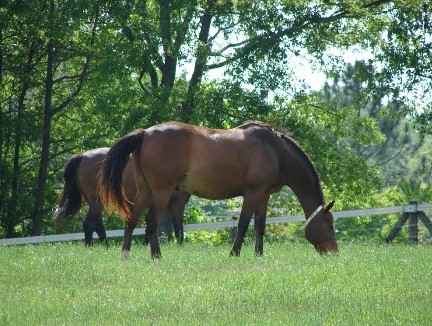
Horses grazing lush pastures may have trouble consuming enough dry matter until the forage matures.
Some fibers are more digestible and contribute to the energy content of the diet. Fibers that are more digestible include sugar beet pulp, soybean hulls, and dried citrus pulp. Examples of less-digestible fiber sources are peanut hulls, cottonseed hulls, rice hulls, and straw.
Check the ingredient list on the feed tag to determine relative amounts of digestible and indigestible fiber sources. Feed ingredients are listed from the ingredient that is the highest amount in the feed to that which is the lowest amount. Feeds with a higher fat content, which is listed on the feed label, contain more energy.
Most concentrate feeds for horses contain somewhere between 2.0 and 3.7 Mcal/kg of DE. For this example, we will pick a number somewhere in the middle of this range, say 3.0 Mcal/kg.
Most concentrate feeds contain about 90 percent dry matter. In this case, we can skip the conversion to a dry matter basis that we did with the hay because the nutrient percentages listed on the feed tag generally are expressed in an as-fed basis. Therefore, feeding the horse 2 kg (4.4 pounds) of this feed would allow it to meet its energy requirements (2 kg feed × 3.0 Mcal/kg = 6 Mcal). Add 6 Mcal to the 15 Mcal provided by the hay, and this will give the horse 21 Mcal daily.
The forage example in table 2 assumes that the horse is already eating 2.5 percent of its body weight in forage. This means that it probably will decrease its forage consumption to eat the concentrate feed, and the owner will need to feed the horse more than 2 kg concentrate daily to make up for the decrease in hay consumption.
After juggling numbers a little (table 3), we can feed the horse 3 kg of the concentrate feed and assume it will decrease its hay consumption to 9.5 kg (12.5 kg of total intake – 3 kg of concentrate = 9.5 kg of DM left to eat), and it will meet its energy requirement ([3 kg × 3.0 Mcal/ kg] + [9.5 kg × 1.2 Mcal] = 20.4 Mcal).
Table 3. Nutrients provided by 9.5 kg of poor-quality coastal bermudagrass hay and 3 kg concentrate feed for a 500-kg horse in light work
Because the amount of hay consumed was decreased, the protein delivered by the hay dropped below the amount required by the horse. Luckily, the 3 kg of concentrate feed will easily bump up the horse’s protein intake if the concentrate contains the standard 10 percent crude protein found in most higher-quality feeds for mature pleasure horses ([3 kg concentrate × 0.10] + [9.5 kg × 0.06] = 0.870 kg protein, or 870 g of protein in the hay and grain combined). A higher-quality concentrate probably would contain most of the vitamins and minerals needed by the horse, but because we are in Alabama and horses sweat a lot here, you still should provide the trace mineral salt block.
If we assume that the horse feed is $15.00 per bag (22.7 kg), the total cost of the horse’s daily feed consumption is the cost of its hay, $2.32, plus the cost of the concentrate, $1.98, for a daily total of $4.30. This is only $0.51 more each day than the hay-only diet; however, that adds up to $186.00 a year. If you are feeding several horses or even feeding one horse for an average lifespan of 20 to 30 years, this amounts to a lot of money.
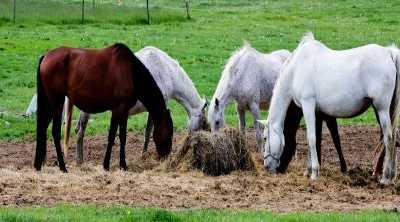
Poor-quality hays may not provide enough energy to meet the horse’s daily requirements. This results in weight loss if the horse does not receive supplemental concentrate feed.
You will have an increase in labor once you start feeding concentrates. Horses usually have to be caught and separated to consume their ration. Because you are feeding more than 5 pounds of concentrate daily, the concentrate ration needs to be divided into at least two meals, again increasing your labor. While the poorer- quality hay was cheaper by the bale, the total cost of your feeding program was increased by purchasing the poorer-quality hay.
Another important consideration is that the 9.5 kg of hay you are feeding the horse each day represents approximately 1.9 percent of the horse’s body weight. If you were feeding this poorer-quality hay to a horse with higher requirements than a pleasure horse, say a pregnant or lactating mare, the increase in concentrate feed needed to meet the horse’s requirements might result in hay consumption dropping below the daily minimum amount of 1 percent of the horse’s body weight in long roughage. This could increase digestive problems in the horse and may lead to behavioral problems such as wood chewing or tail chewing.
Evaluating Hay Quality
How can you spot high-quality hay? Good-quality hays usually share the characteristics of being green in color, being free of weeds and trash, having a high amount of leaves compared to stems, and smelling sweet. However, differences in forage species, growing conditions, harvesting, and storage of the hay can make visual comparisons of hay quality difficult.
The best option for determining hay quality is a forage test (example on page 7). This laboratory test is used to evaluate the nutritive value of the hay. Many top hay producers routinely run forage tests on their hays and provide the results to the purchaser. You also can send in a sample of the hay to have the nutritional content evaluated.
Forage samples can be evaluated at the Soil Testing Laboratory at Auburn University (aces.edu/anr/soillab). Find information on how to take a hay sample in Collecting Forage Samples for Laboratory Analysis (Extension publication ANR-2224).
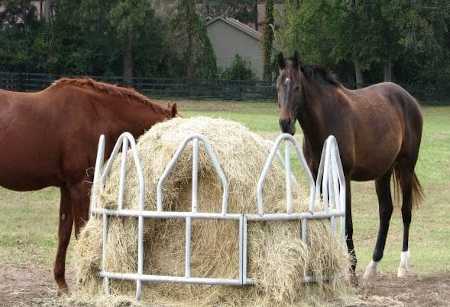
The best option for determining hay quality is a forage test to evaluate the nutritive value of the hay.
The first step in evaluating forage test results is to check the dry matter content of the hay. You do not want to pay for a lot of water, and high-moisture hays (greater than 14 to 18 percent) have a tendency to mold or to heat (ferment) after storage. Both of these conditions lower the quality and palatability of the hay. Conversely, hays that are too dry (less than 10 percent moisture) are brittle and may have lost leaves, reducing quality and palatability.
The next step is to check the percent crude protein (CP). Because protein is an expensive ingredient in the diet, higher-protein contents are desirable when comparing hays. In grass hays, typical crude protein values run between 8 and 12 percent. Grass hays less than 8 percent should be rejected for purchase if possible.
You also can pull out your calculator and check that the CP provided by the amount of hay you intend to feed the horse each day meets its daily requirements as outlined in the National Research Council’s Nutrient Requirements for Horses (2007).
Forage tests also report acid detergent fiber (ADF) and neutral detergent fiber (NDF). The ADF is the percentage of indigestible cell wall material found in the forage. Forage with a lower ADF is more digestible and has greater energy content than one with a high ADF; therefore, lower ADF values are more desirable. Hays with ADF values above 45 percent have little nutritive value. Forage with an ADF of less than 31 percent would be considered excellent.
The NDF represents the structural, or cell wall material, found in the forage. This value is inversely related to the amount of forage the animal will consume. A low NDF value is therefore an indication that the animal will eat more of the forage. An NDF of less than 40 percent is considered very good, while one over 65 percent usually indicates that the forage will not be consumed readily by the horse.
The final step is to look at the energy content in the forage. There may be several energy values listed, such as net energy (NE) for metabolism, gain or lactation, and total digestible nutrients (TDN), but the DE value that we used in our previous calculations is usually nowhere to be found. If DE is not included, Relative Forage Quality (RFQ) Index should be used. This value is reported on all Auburn University Forage Samples. The value is calculated based on the ratio of CP to NDF and ADF and takes into account digestibility and animal intake and values range from 0 to 300. Index values below 100 will need to be supplemented for all classes of horses. From 100 to 110 is adequate for an idle horse, 110 to 125 for brood mares and working horses, and 120 to 140 for nursing mares and hard-working horses without additional supplementation.
Roughly 1 kg of TDN is equivalent to 4.4 Mcal of DE. This is a useful conversion if you are trying to figure out if the forage will meet your horse’s energy requirement. If you are just comparing two or more forages, however, you can skip the math and choose the forage with the higher TDN as the more desirable option in terms of supplying energy to the horse. Bermudagrass hays that are above 58 percent TDN are considered very good, while those falling below 54 percent TDN are considered poor.
Basically you want the moisture content of the forage to be just right, the CP and TDN values to be high, and the ADF and NDF values to be low.
Getting the Most Bang for Your Hay Buck
Once you have purchased hay, make sure that you are doing all you can to preserve its quality while it is stored. Ideally, hay should be stored off the ground, under a roof, and off limits to animals.
Hay that is properly stored will retain most of its nutritive value for several years. Stored hay loses vitamin A content over time, but most of this loss occurs in the first 6 months of storage, and vitamin A content decreases little after this time. Stored hay will continue to dry out over time, which may increase leaf shatter, dust, and wastage when it is fed.
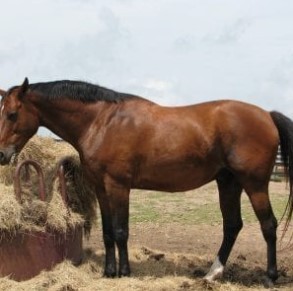
A horse-safe round bale feeder will reduce hay waste and hay costs.
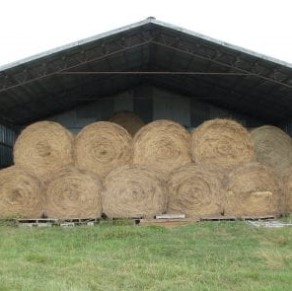
Ideally, hay should be stored off the ground, under a roof, and off limits to animals.
Feeding practices can have a large influence on the amount of hay wasted by horses. Most horse owners estimate the amount of hay provided in each feeding because it is not practical to weigh out hay at each feeding. In this situation, it is better to overestimate the amount of hay needed to ensure that the horse is receiving enough. This will result in a small amount of hay left uneaten at the next feeding. While this practice can increase hay waste, it helps to ensure that the horse is receiving enough long roughage.
Horses will waste hay that is fed in a round bale or off the ground. A horse-safe hay feeder can go a long way in reducing hay costs.
While the initial cost of high-quality hay may hurt your budget when the hay is purchased, it saves money in the long run. Higher-quality hay usually results in a lower yearly feed cost because less concentrate feed has to be fed. In addition, feeding more hay and less concentrate is beneficial to the horse’s digestive system and results in a more contented horse.
Source : aces.edu